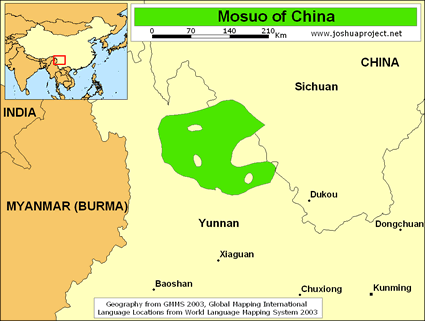The Mosuo have been officially included as part of the Naxi nationality. The Mosuo deeply resent this and despise being called Naxi. The two groups have a different language, religion and culture.
According to Mosuo legends, the ancestors of today's Naxi and Mosuo migrated down from the Tibetan Plateau about 1,000 years ago. Part of the group stopped at Lugu Lake and became today's Mosuo people, while the remainder continued south until they reached Lijiang where today they are the Naxi. After many centuries of separation, the two groups have developed major ethnolinguistic differences.
The Mosuo have a matriarchal and matrilineal society. The azhu system means all property and assets are transferred to the female side of the family, from mother to youngest daughter. Even the family name is passed down from the mother. Instead of taking a husband, Mosuo women are allowed to have "walk-in" relationships. Men are only allowed to visit their lovers at night. They must leave the woman's house early the next morning and return to their mother's home. If a child is born, the responsibility to raise the child is borne by the mother and her brothers., They often don't know the identity of the father. Despite pressure from the government to discontinue the azhu system, a 1994 study revealed 60% of the Mosuo still conform to this way of life.
Tibetan Buddhism has a strong grip on the Mosuo. Altars of white stones are piled in pyramid formations on every corner and outside most homes. "Because the Mosuo have no written language, shamans had to memorize the equivalent of 71 volumes of text and recited them word for word during funerals, births and other events. From the first utterance to the last, a master's recitation took up to 60 hours."
There had never been a known Mosuo believer until recently, when a Mosuo family came to Christ under quite extraordinary, supernatural circumstances. This family shared the gospel with their friends and neighbors, and today there are a substantial number of Christian believers among the Mosuo. This is an excellent start! But there is a great need for the gospel to spread to every Mosuo family throughout China.
Pray for the gospel to spread far and wide among the Mosuo people.
Pray for the Holy Spirit to raise up and send out hundreds of Mosuo Christ followers to their neighbors.
Pray for Mosuo Christ followers to show others the way to obedience to Christ, specifically in regard to being faithful to their spouse.
Scripture Prayers for the Mosuo in China.
Operation China, Asia Harvest, Copyrighted © Used with permission
| Profile Source: Joshua Project |











